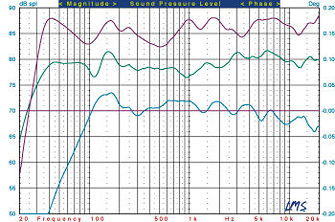Definitive Technology BP2006TL Speaker System Page 3
Set the bass management to "large" with the C/L/R 2300, and the most important channel in your system becomes one of the most potent, too. Be careful, though—this baby's got the power to caress you with sweetness and then grab you by the throat and shake you. Sound effects that pan across the front soundstage never sound sunken or constrained in the center with no changes in tonal quality. In a movie like The Red Violin, where the voice of the violin is as important a voice as any other character's, the C/L/R 2300 is goose-bumpingly great at revealing both the subtlety and the majesty of the tragic violin's voice.
Another advantage of incorporating the powered woofer into the C/L/R 2300 is that it creates a great bookshelf speaker, one you could easily use to make a great left/center/right combination… or even a five-channel nonbipolar home theater.
The BP2X bipolar surround speakers have been around for a while, but I know why Def Tech sent them. We can spend a lot of time arguing the merits of dipoles, bipoles, and direct radiators for the rear-effect speakers, but the simple answer is that the BP2Xs sounded great in this system. Fronts and rears worked together beautifully as one coherent whole.
I was already prepared to gushingly recommend this system when Def Tech sent a second pair of BP2006TL speakers with the suggestion that I try using them for the surround channels. They even included a little adapter that allowed me to hook my preamp's LFE output to the LFE input of all four of the BP2006TL towers. I now had four 8-inch subwoofers filling the room with 1,000 watts of power.
Listening to an action film with four of the BP2006TLs powered up is like strapping yourself onto a rocket sled and lighting the fuse. Hold on for dear life because, man, it's one hell of a ride! I'm still having flashbacks from the first 20 minutes of Saving Private Ryan. The scene in Contact where you can hear Ellie Arroway's (Jodie Foster) heart beating as she's debriefed in the hospital made my heart skip a beat, and the launch sequence in Apollo 13 made the hair on the back of my neck stand up. My couch shook like a teenager on his first date.
It wasn't just that there was more bass—it was the utter authority and sheer dominance with which the system took over the room. Bass came from everywhere. Even more surprising was the extra thrill that it added to the rear effects, combining a sure sense of direction with a definite sense of spaciousness. With a music DVD like Stop Making Sense, the feeling of being there was so strong that I kept wondering why my room lights weren't going on and off in time with those on stage.
Of course, not everyone is willing or able to use a set of tower speakers in the rear. If you can, do. It's a deliciously, deliriously entertaining setup. If you can't, the BP2Xs will mount up and still give you a system that packs more wallop with less from your wallet than you'll find almost anywhere else. Definitely buy your tickets for this one! With the BP2006TL system, Definitive Technology has hit the ball out of the park—and I don't think it has come down yet.
Highlights
• Big sound from relatively small tower speakers
• Great center channel that would also make a good bookshelf speaker
HT Labs Measures: Def Tech BP2006TL Speaker System

This graph shows the quasi-anechoic (employing close-miking of all woofers) frequency response of the BP2006TL main L/R (purple trace), C/L/R 2300 center channel (green trace), and BP2X surround channel (blue trace). All passive loudspeakers were measured at a distance of 1 meter with a 2.83-volt input and scaled for display purposes.
On-axis response of the BP2006TL L/R measures +1.48/-4.13 decibels from 200 hertz to 10 kilohertz. The -3dB point is at 33 Hz, and the -6dB point is at 31 Hz. Impedance reaches a minimum of 2.99 ohms at 123 Hz and a phase angle of 20.25 degrees at 166 Hz. Sensitivity is 86.5 dB from 500 Hz to 2 kHz.
On-axis response of the C/L/R 2300 center measures +3.66/-1.58 dB from 200 Hz to 10 kHz. An average of axial and (+/-15 degree) horizontal responses measures +2.12/-1.99 dB from 200 Hz to 10 kHz. The -3dB point is at 30 Hz, and the -6dB point is at 26 Hz. Impedance reaches a minimum of 2.89 ohms at 326 Hz and a phase angle of 43.78 degrees at 1.06 kHz. Sensitivity is 88 dB from 500 Hz to 2 kHz.
Three-point averaged response of the BP2X surround measures +0.45/-4.14 dB from 200 Hz to 20 kHz. The -3dB point is at 98 Hz, and the -6dB point is at 83 Hz. Impedance reaches a minimum of 3.09 ohms at 70 Hz and a phase angle of -29.29 degrees at 158 Hz. Sensitivity is 89.5 dB from 500 Hz to 2 kHz.—AJ

- Log in or register to post comments




































































